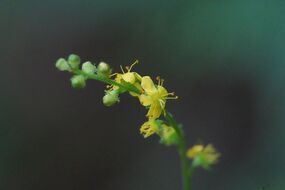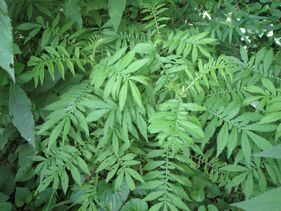Three Agrimony Species
Our three species are all characterized by alternating large and small leaflets on each compound leaf. One of these is very different from the other two; a good hand lens is helpful to separate the two similar species.
Soft agrimony (Agrimonium pubescens). A common woodland plant, with 5 to 13 toothed leaflets. Stems are uniformly hairy; the best field mark is the uniformly downy leaf undersides, best seen with a hand lens. |
Woodland agrimony (Agrimonia rostellata). Almost identical to Soft agrimomy, but this species has downy, not hairy, upper stems. Leaf bottom hairs are confined to the veins. |
Southern agrimony (Agrimonia parviflora). Leaves are very different from the previous two species, making this species easy to identify. Numerous leaflets are thinner and more sharply toothed than those of the preceding two species. |


